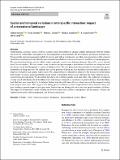Spatial and temporal variations in interspecific interaction : impact of a recreational landscape
Abstract
Anthropogenic activities, such as outdoor recreation, have the potential to change complex interactions between wildlife and livestock, with further consequences for the management of both animals, the environment, and disease transmission. We present the interaction amongst wildlife, livestock, and outdoor recreationists as a three-way interaction. Little is known about how recreational activities alter the interaction between herbivores in areas extensively used for recreational purposes. We investigate how hiking activity affects spatio-temporal co-occurrence between domestic sheep (Ovis aries) and red deer (Cervus elaphus). We used camera traps to capture the spatio-temporal distribution of red deer and sheep and used the distance from the hiking path as a proxy of hiking activity. We used generalized linear models to investigate the spatial distribution of sheep and deer. We analysed the activity patterns of sheep and deer and then calculated their coefficients of temporal overlap for each camera trap location. We compared these coefficients in relation to the distance from the hiking path. Finally, we used a generalized linear mixed-model to investigate which factors influence the spatio-temporal succession between deer and sheep. We do not find that sheep and red deer spatially avoid each other. The coefficient of temporal overlap varied with distance from the hiking trail, with stronger temporal co-occurrence at greater distances from the hiking trail. Red deer were more likely to be detected further from the path during the day, which increased the temporal overlap with sheep in these areas. This suggests that hiking pressure influences spatio-temporal interactions between sheep and deer, leading to greater temporal overlap in areas further from the hiking path due to red deer spatial avoidance of hikers. This impact of recreationists on the wildlife and livestock interaction can have consequences for the animals’ welfare, the vegetation they graze, their management, and disease transmission.
Citation
Marion , S , Demšar , U , Davies , A , Stephens , P A , Irvine , R J & Long , J 2022 , ' Spatial and temporal variations in interspecific interaction : impact of a recreational landscape ' , European Journal of Wildlife Research , vol. 68 , 36 . https://doi.org/10.1007/s10344-022-01584-9
Publication
European Journal of Wildlife Research
Status
Peer reviewed
ISSN
1612-4642Type
Journal article
Collections
Items in the St Andrews Research Repository are protected by copyright, with all rights reserved, unless otherwise indicated.

